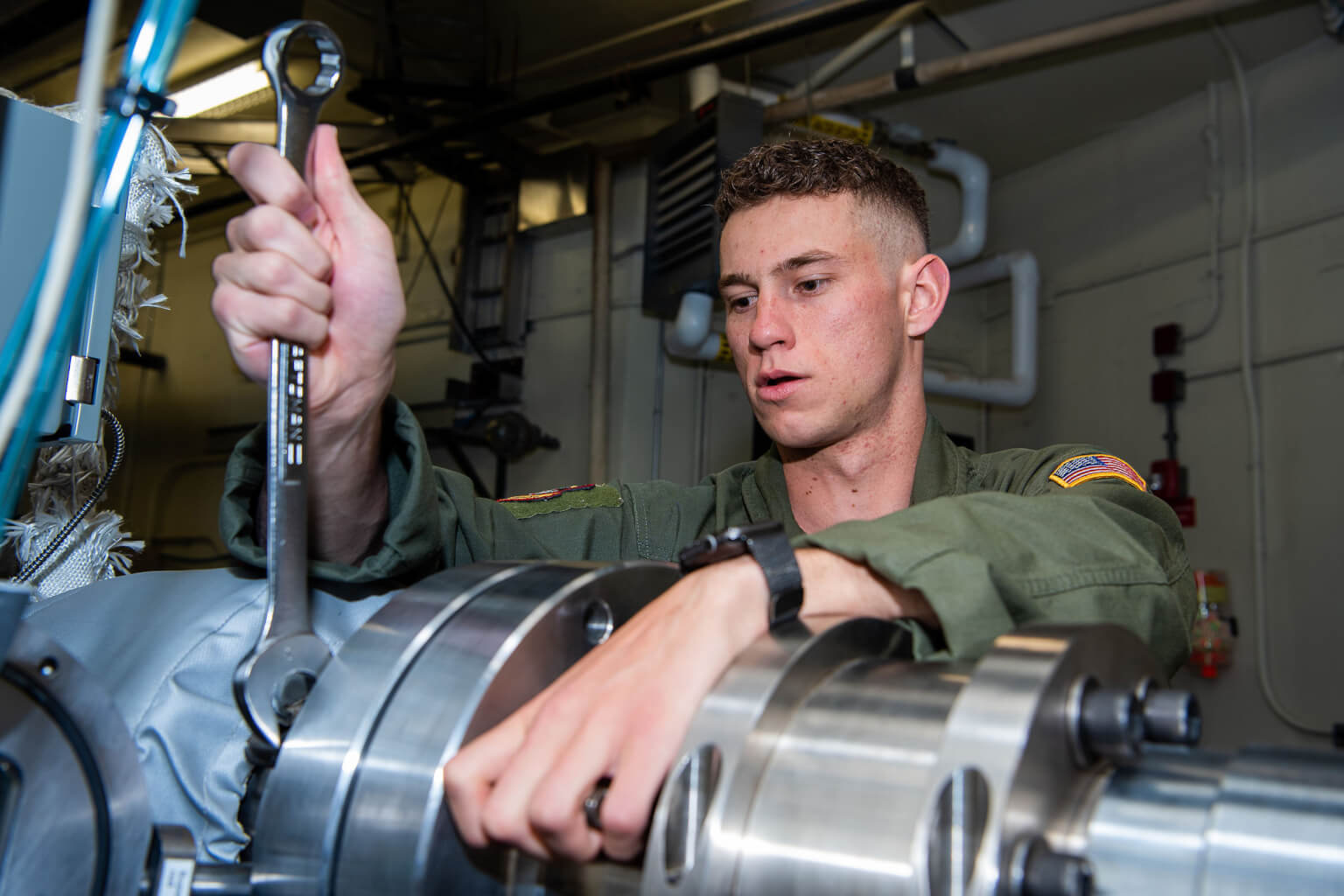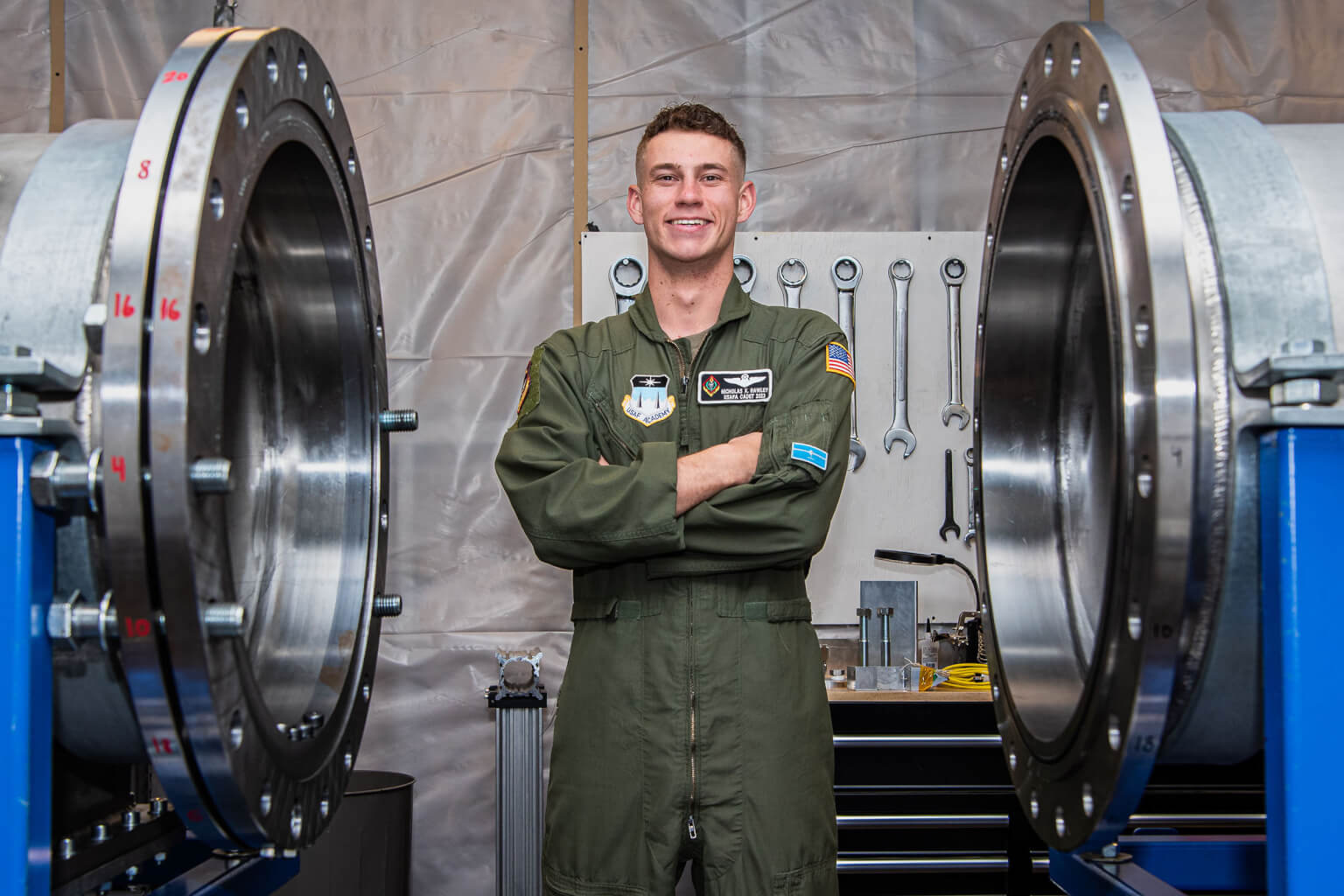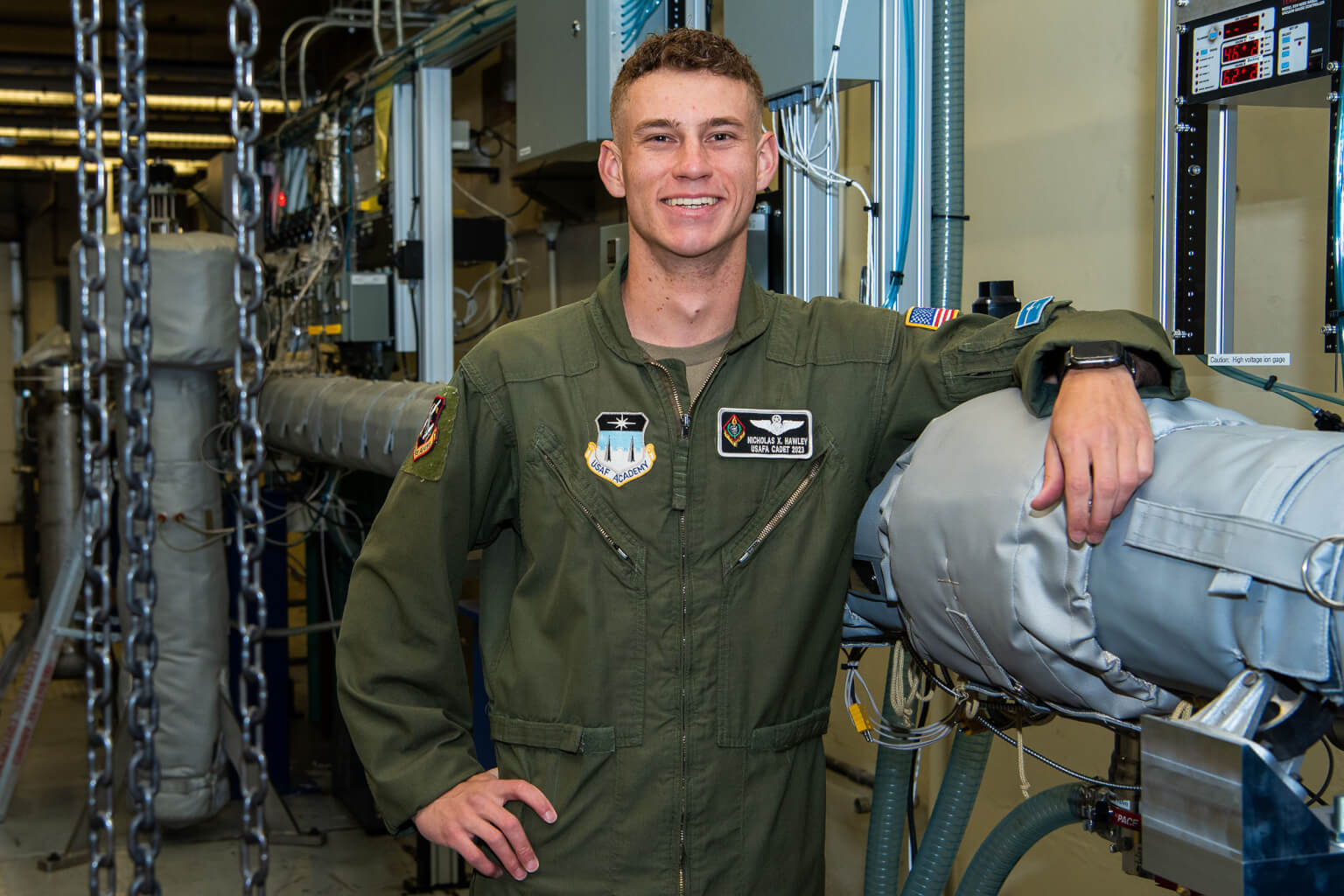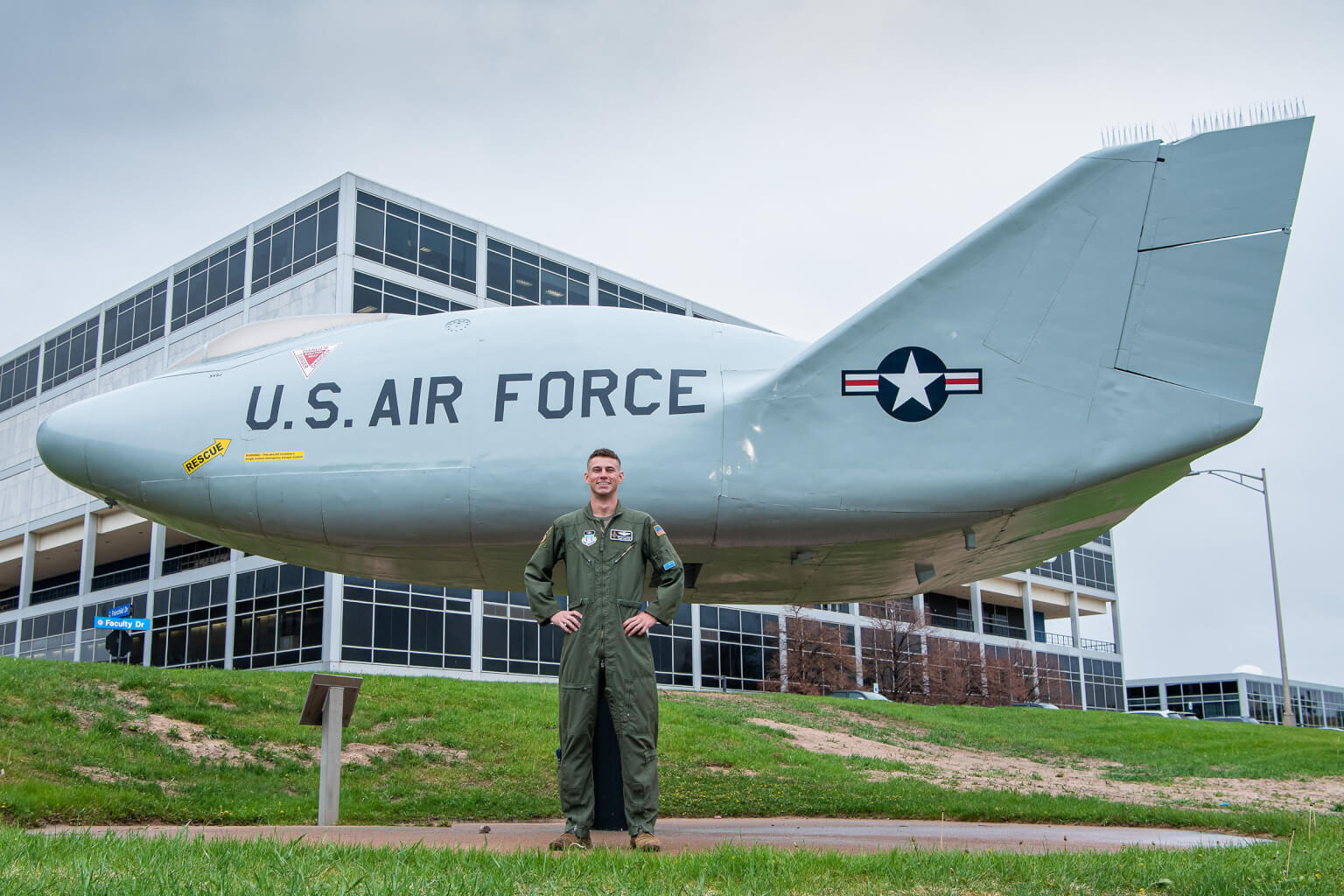Recent grad looks forward to role in hypersonic research
 Second Lt. Nicholas Hawley works on the combustion shock tube, on which he completed much of his experimental hypersonic research. (U.S. Air Force photo by Justin R. Pacheco)
Second Lt. Nicholas Hawley works on the combustion shock tube, on which he completed much of his experimental hypersonic research. (U.S. Air Force photo by Justin R. Pacheco)
By Randy Roughton
U.S. Air Force Academy Strategic Communications
U.S. AIR FORCE ACADEMY, Colo. Early in 2nd Lt. Nicholas Hawley’s first year as a U.S. Air Force Academy cadet, his academic advisor knew he was destined for greatness. What Col. Doug Wickert did not know was the role Hawley would play in the military’s transition to hypersonic aircraft and weapons soon after graduating in June.
“There was a clear hint of greatness there,” said Wickert, who is also the head of the Department of Aeronautics. “It was a spark that you could feel was just waiting for ignition.”
During Hawley’s Academy career, which included a double major in aeronautical engineering and applied mathematics, Wickert said he became the first Academy or ROTC cadet to receive a Developing the Airmen We Need-Education doctorate slot in the program’s history. The Department of the Air Force-funded program provides up to 15 Airmen and Guardians opportunities to pursue master’s or doctorate degrees at the universities of their choice.
Headed to South Bend
Hawley chose a three-year doctorate program in hypersonic turbulence characterization and pushed jet reaction control at the University of Notre Dame in the fall. He also received a three-year National Science Foundation Fellowship that he will use for the program. Hawley chose Notre Dame over other schools, partly because the school has the first Mach 10 hypersonic quiet tunnel, he said. A quiet tunnel can flow air at hypersonic velocities without the turbulence normally developing at such high speeds. “More school might not sound like it’s the best, but I think I will be doing some very meaningful work in a new facility at Notre Dame,” Hawley said. “One of the things that excite me the most about engineering and learning, in general, is being able to develop some solutions to problems that have never been solved or even encountered.”
 Second Lt. Nicholas Hawley takes a break in front of the Ludwieg tube, a wind tunnel that produces supersonic flow for short intervals. During his Academy career, Hawley conducted high-Mach (Mach 6) experiments, primarily for turbulence modeling over various geometries. The aeronautical engineering laboratory compares experimental data against computational fluid dynamics data. (U.S. Air Force photo by Justin R. Pacheco)
Second Lt. Nicholas Hawley takes a break in front of the Ludwieg tube, a wind tunnel that produces supersonic flow for short intervals. During his Academy career, Hawley conducted high-Mach (Mach 6) experiments, primarily for turbulence modeling over various geometries. The aeronautical engineering laboratory compares experimental data against computational fluid dynamics data. (U.S. Air Force photo by Justin R. Pacheco)
 Second Lt. Nicholas Hawley stands in front of the Academy’s combustion shock tube, where cadets test and characterize the combustion properties of different aerosol and liquid fuels. Cadets try to solve the problem of predicting fuel ignition and combustion at high speeds and small-time scales, like micro to milliseconds. (U.S. Air Force photo by Justin R. Pacheco)
Second Lt. Nicholas Hawley stands in front of the Academy’s combustion shock tube, where cadets test and characterize the combustion properties of different aerosol and liquid fuels. Cadets try to solve the problem of predicting fuel ignition and combustion at high speeds and small-time scales, like micro to milliseconds. (U.S. Air Force photo by Justin R. Pacheco)
Following his passion
After completing the doctorate program, Hawley will head to EURO-NATO joint jet pilot training at Sheppard Air Force Base, Texas.
Hawley, the son of a Kiowa helicopter pilot, was a Soaring instructor pilot during his last three years as a cadet with the 94th Flying Training Squadron. He had more than 200 instructional flights and 125 hours in the glider from his time as an instructor pilot.
“It really is the perfect combination of my passion for teaching others and my passion for flying and aviation,” Hawley said. “Being an IP ” helped me realize that I wanted to be a pilot in the Air Force and drove me to apply for ENJJPT. I have made some of my best friends through the Soaring program that I know will last a lifetime, and I honestly could not imagine being a cadet without being a Soaring IP.”
During his time as a cadet, Hawley conducted independent research in aeroelasticity, also known as body freedom flutter. He became the youngest presenter when he shared his research at the American Institute of Aeronautics and Astronautics Region 5 Undergraduate Conference at the University of Colorado-Colorado Springs in 2022. AIAA Scitech later published his research paper, “Typical Section Models for Body Freedom Flutter.”
Hawley also developed hypersonic trajectory models for his cadet summer research at Lawrence Livermore National Laboratory in California. During his first week in the program, he discussed uncertainty with Wickert because he had never used that type of code or performed numerical trajectory analysis before.
Within a week, Hawley taught himself all he needed to know and began work on advanced modeling currently used by Sandia National Laboratories for the hypersonic flight trajectories of other vehicles, including for re-entry.
A link to the past
Wickert said he sees a connection between where the Air Force is headed in 2023 and what the Army Air Corps faced a century earlier as it transitioned toward air warfare. He also shared a similar link between Hawley and another student in 1923.
At that time, the Army Air Corps had fallen behind its aviation competitors and recognized that aviation would be crucial in the war to come, so the service created the Air Service Engineering School in Dayton, Ohio, to educate officers in future conflict technology. The Class of 1923 had a young lieutenant named James “Jimmy” Doolittle, who graduated from the Air Service Engineering School in June 1925. Doolittle achieved fame when he engineered the Doolittle Raid on Tokyo early in World War II.
“I see a neat symmetry and parallel with Nick receiving the first DAWN-ED Fellowship for hypersonic,” Wickert said. “Lieutenant Doolittle was Class of 1923; Lieutenant Hawley was Class of 2023. Both studied aeronautical engineering applications that promised to be decisive in a future conflict.
“The future of our Air Force and our nation depends on the Nick Hawleys’ success. We all hope that there is no next war, but if there is, we will need our Jimmy Doolittles. Nick Hawley might just be our next Jimmy Doolittle.”
 Second Lt. Nicholas Hawley stands in front of the Martin-Marietta SV5-J Lifting Body. The body was used to explore flight characteristics and develop pilot techniques for space shuttle reentry flights. (U.S. Air Force photo by Justin R. Pacheco)
Second Lt. Nicholas Hawley stands in front of the Martin-Marietta SV5-J Lifting Body. The body was used to explore flight characteristics and develop pilot techniques for space shuttle reentry flights. (U.S. Air Force photo by Justin R. Pacheco)